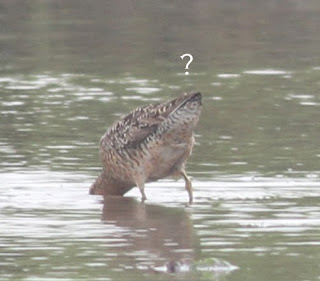The southbound shorebird migration has begun in Connecticut, which is always cause for celebration. Yesterday I had a nice half-day of birding a few coastal hotspots, the best of which was Griswold Point in Old Lyme. Among the arrivals from the north was a small flock of six Short-billed Dowitchers.
While normally this would not be at all notable, the subspecific composition of this flock was interesting. Here in southern New England the common subspecies is
griseus, but very small numbers of
hendersoni can often be picked out among them, especially early in migration when adults are still in good plumage (according to the literature
hendersoni averages earlier fall migration than
griseus as well). Here in CT, this usually means no more than a few
hendersoni per day on your best day (we don't get the flocks of hundreds of SBDO that you see at South Beach or Jamaica Bay).
In yesterday's very instructive flock, four of the birds were straightforward
hendersoni, just one was your typical
griseus, and one bird left me scratching my head. Each bird is labeled in the photos that follow. My apologies for the mediocre images...if I had tried to get any closer to the birds I would probably still be extracting myself from waist-deep mud.
In this set of images I'm going to focus on the mystery bird, labeled with a question mark in the photos. Not all dowitchers can be safely assigned to subspecies, even adults in breeding plumage. For instance, there are known to be intermediate/intergrade birds from the Hudson Bay region. Birds from west of the Hudson Bay are
hendersoni, while birds east of there are
griseus. This mystery bird may well fall into that category.
All four
hendersoni are variably bright orange below with
coloration extending all the way to the vent. Breast sides are
more spotted than barred. Face is about the same bright orange color as
the underparts. Upperparts are broadly striped/edged with gold.
As compared to the
hendersoni, the single
griseus is a very dull bird. There's a dingy orange wash only to the face and upper breast. There is heavy barring along breast sides and down flanks. The golden barring and edging to the upperpart feathers are thinner and less striking.
As usual, you can click each thumbnail for a larger version.
 |
| In this view, the mystery dow shows extensive yet dull orange below. |
 |
| A bit more heavily marked on the sides than your typical hendersoni. |
 |
| Tough to see without zooming in, but the mystery dow shows some orange all the way to the vent. |
 |
| Here it is cropped all the way up. |
 |
| Again showing a dingy-looking breast. Finally a decent angle to judge upperpart pattern, which also appears intermediate between the hendersoni to the left and the griseus to the right, as far as the golden 'tiger stripes' go. |
 |
| Head-on, breast markings perhaps appearing more hendersoni-like after all. |
 |
| One of those tertials is really well-marked, again hendersoni-like. But not a clear orange face; instead, duller and finely speckled. |
I'm fine putting this bird in the "intermediate" category. No need to assign a name since it doesn't seem to fit neatly into either taxon. If I was forced to pick one, I'd go with
hendersoni because I think the bird is closer to that end of the spectrum. It definitely stands out from what I consider to be the normal range of variation among the
griseus I see here each summer.
As always comments are welcome.
- Nick














Nice post and photos! I agree with your synopsis and is exactly the conclusion I would have come to. I do see birds like this often and feel they are probably hendersonii too, but it's hard to tell without a known benchmark. I also remember reading that the two sub-species hybridize in the central part of their breeding range..so that's a Pandora's box right there if I remember reading that correctly..
ReplyDeleteIt would be nice if more birders took a crack at sorting these out, just to get a better handle on how many hendersoni we get. Does it vary widely from year to year or is it a pretty consistent proportion? Definitely a group that helps hone ID skills.
ReplyDelete